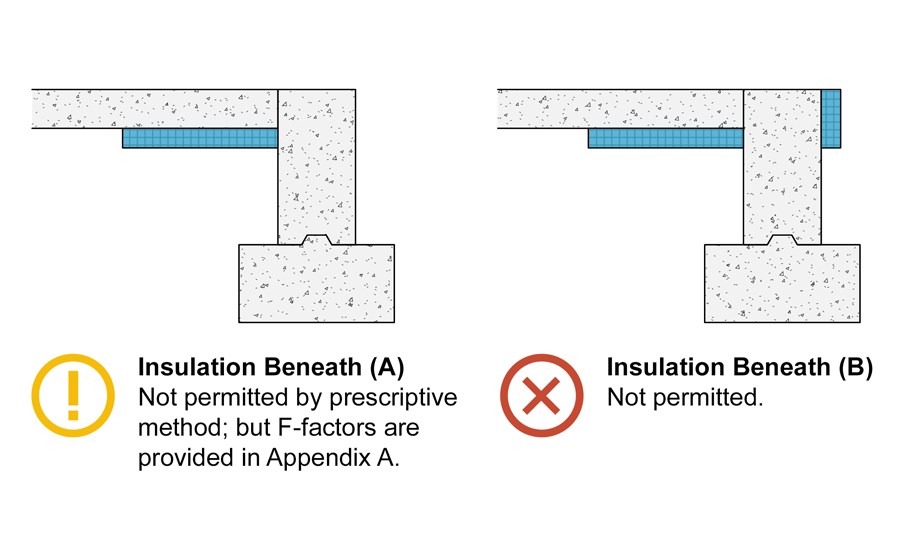Slab-on-grade insulation. It seems like it should not be so complicated. Yet, slab-on-grade insulation can be arranged in a number of configurations, each with pros and cons. One arrangement may be more conducive to maintaining a continuous thermal barrier from a wall down through its foundation but it allows unsightly exposure along the building perimeter. Another configuration may better conceal the insulation yet it allows an undesirable thermal short along the edge of the slab. A particular solution may provide great continuity of the thermal barrier but be problematic in terms of constructability.
The prospect of slab-on-grade insulation can become complicated. When it does, project teams will often lean on energy codes and standards to settle the issue.
Slab-on-Grade Insulation Requirements in ASHRAE Standard 90.1
Let's unpack the issue in the context of ANSI/ASHRAE/IES Standard 90.1 - Energy Standard for Buildings Except Low-Rise Residential Buildings.
First, the standard defines two classes of slab-on-grade:
Heated slab-on-grade floor: a slab-on-grade floor with a heating source either within or below it.
Unheated slab-on-grade floor: a slab-on-grade floor that is not a heated slab-on-grade floor.
Heated slabs-on-grade will feature hot water pipes or coils embedded within or beneath the slab to provide space heating. Heat losses from heated slabs are greater than that of unheated slabs because the temperature is warmer. For unheated slabs, insulation may or may not be required depending on your climate zone, whether or not the project is residential, and which edition of Standard 90.1 is being referenced.
The R-value specification in standard defines both the rated R-value of the insulation and the depth or width of the insulation. For example, "R-10 at 36 in." means that insulation with a rated thermal resistance of 10 must be installed and that the insulation must extend a distance of 36 inches form the top surface of the slab.
A review of the Standard 90.1's building envelope prescriptive requirements will reveal a reference to a "maximum assembly F-factor" rather than a U-factor, as one would see for other envelope components.
Wait...F-factor?
In contrast to the U-factor for floors, the F-factor for slab-on-grade floors is expressed per linear foot of building perimeter. F-factors are provided for both heated and unheated slabs.
The F-factors are provided for three insulation configurations (verbatim below from the 2016 edition with my emphasis):
Horizontal Insulation: Continuous insulation is applied directly to the underside of the slab and extends inward horizontally from the perimeter for the distance specified, or continuous insulation is applied downward from the top of the slab and then extends horizontally to the interior or the exterior from the perimeter for the distance specified.
Vertical Insulation: Continuous insulation is applied directly to the slab exterior, extending downward from the top of the slab for the distance specified.
Fully Insulated Slab: Continuous insulation extends downward from the top of the slab and along the entire perimeter and completely covers the entire area under the slab.
The F-factors for slab-on-grade floors are defined in Standard 90.1. Consult Appendix A (Table A6.3.1 in the 2016 edition) for a tabulation of assembly F-factors for slab-on-grade floors based on the arrangement and rated R-value of the applied insulation.
These F-factors are acceptable for all slab-on-grade floors, but you need to make sure the insulation is rated and applied accordingly.
Regarding the rated R-value of insulation on slab-on-grade floors
As clarified in Appendix A of Standard 90.1-2016:
- The rated R-value of insulation shall be installed around the perimeter of the slab-on-grade floor to the distance specified. Exception: For monolithic slab and footing, the insulation must extend only to the bottom of the footing or the distance specified, whichever is less.
- Insulation installed inside the foundation wall shall extend downward from the top of the slab a minimum of the distance specified or to the top of the footing, whichever is less.
- Insulation installed outside the foundation wall shall extend form the top of the slab directly down for the full distance, or at least down to the bottom of the slab and then horizontally until the specified distance is achieved. In all climate zones, the horizontal insulation extending outside of the foundation shall be covered by pavement or by soil a minimum of 10 inches thick.
Sound complicated?
While ASHRAE's performance requirements for slab-on-grade insulation has shifted over time, the basics of the standard's permitted applications of slab-on-grade insulation have remained largely unchanged for the past several editions of Standard 90.1.
In hopes of offering some clarity, the figure below depicts acceptable and unacceptable slab-on-grade insulation applications. This figure is adapted from a similar figure in the ASHRAE's 90.1 User's Guide. (This information applies at least as far back as the 2007 edition of standard. Only two states have an energy code less stringent than Standard 90.1-2007, so I did not dig deeper than the 2007 edition.)
|
|
|
Figure 1: Slab-on-Grade Insulation Applications. |



Recent Comments
These are actually very helpful tips. It is...
This is the most beneficial blog for all...
This blog is a great resource for anyone...
Thank you for sharing this important information. I...
This is a very interesting subject of the...